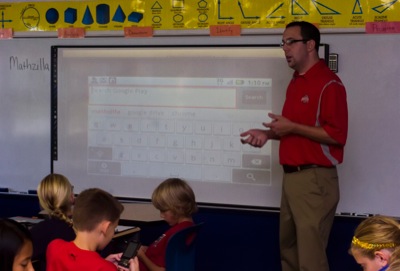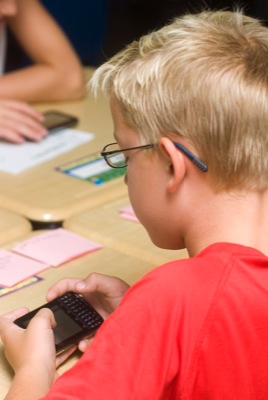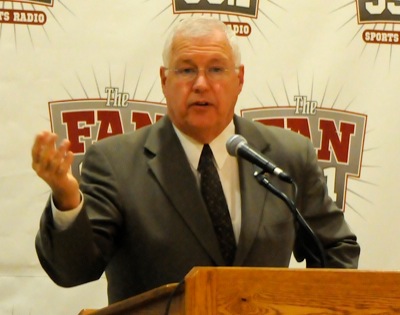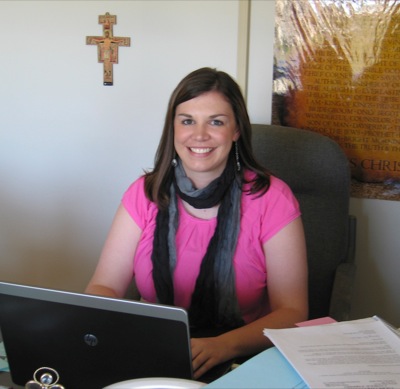Friday, September 14th, 2012
New age of learning
Use of computer technology increasing for more students
By Amy Kronenberger

Photo by Margie Wuebker/The Daily Standard
St. Marys fifth-graders Emily Clements, right, and Andrew Vogel practice a math vocabulary lesson as they learn to use their new smartphones. Third-, fourth- and fifth-graders received the technology Monday. It is the fifth year for the district's smartphone program.
ST. MARYS - Slate and chalk are out and smartphones are in at St. Marys City schools.
The district pioneered the use of the technology in the classroom four years ago and now provides free smartphones to all students in grades 3-5.
Technology coordinator Kyle Menchhofer said 100 schools are modeling their own programs after St. Marys'. The efforts also have been published and officials have worked with colleges to develop programs.
"Schools need to be willing to work with each other to find the best options," Menchhofer said.
Elementary students received 440 new devices from Altell on Monday. The telephone and texting aspects of the smartphones were disabled, rendering it a learning device only. Students use the small keyboard for writing and other assignments and can do Internet research.
"A lot of people have complained the keyboards are too small for writing assignments," he said. "But they have smaller hands and have done just fine. Kids are actually becoming faster typers on those keyboards than they are on regular keyboards."
No texting lingo is allowed, Menchhofer said. Proper spelling, grammar and punctuation are mandated.
Scott Newcomb's fifth-grade math class was trained on the device Wednesday with students learning how to retrieve free math apps and solve problems. Officials from eTech Ohio, a state technology agency, observed the program via teleconference.
"They wanted to see how students and teachers use and interact with the devices," Menchhofer said. "They wanted to see how the program has been going."
Students Zach Hesse and Emily Clements said the devices make learning a lot easier and more fun. They learned, however, that if they enter a wrong answer, the phone will vibrate, causing a buzzing sound if it's lying on the desk.
"It's embarrassing," Clements said laughing. "But if it buzzes a wrong answer, I just hold it up so no one can hear it."
Andrew Vogel said the devices are a big improvement over pencil and paper.
"I like it a lot better because it's digital," he said. "You don't have to use a pencil or worry about it breaking. You just put the answer in and there it is."
Newcomb said most of his students already use a similar device at home and are quick studies. He's noticed kids who were previously quiet are opening up and having fun with it.
"There's a lot of collaboration with them," he said as the students talked, laughed and shared their work with each other. "They want to share what they're learning. You can hear the excitement in here."
Menchhofer said students and teachers interact between devices, sharing lectures, assignments and tests using programs such as Google Docs.
Through Google Docs teachers can upload worksheets, homework assignments, tests and math problems to the students' accounts. Students then complete the assignment and send it back for grading.
Menchhofer said Google Docs has programs similar to Microsoft Word, Excel and PowerPoint. The program also makes financial sense.
"Microsoft Office is getting so expensive to install on all the school computers, but Google Docs is free," he said.
The program enables students to start their work on their devices at school and finish them on their home computer.
Most school officials agree textbooks will be phased out for online versions, but the price of online books will need to come down first, Menchhofer said.
"Textbooks to me are too big to be read on a smartphone - it's too small a screen; there's too many issues with that," he said. "It's coming, though; it's just not coming as fast as most people would like."
St. Marys first began their program in the 2008-2009 school year through Verizon, which charged a monthly service fee of $29.99. St. Marys received a 57 percent discount through E-Rate, a discount program under the direction of the Federal Communications Commission. The amount of discount is based on the number of students using the free or reduced lunch program.
This year Altell outbid Verizon, offering $29 per month. The school also qualified for an almost 60 percent discount from E-Rate.
Menchhofer said businesses have changed a lot in the last 100 years because of computers and technology while schools have not. Students still sit at their desks in neat rows with the "all-knowing teacher" standing at the front of the room, he said.
"That's just not the way it is anymore, and people have a hard time understanding that," he said.
Schools need to focus more on hands-on learning to better cultivate communication, critical thinking, and creative and collaboration skills, he said.
"Colleges are constantly telling us we're not preparing the kids well enough, and they're right, but then the kids go to college and they teach in the exact same way," he said. "Therein lies the problem. They need to make drastic changes."

Photo by Margie Wuebker/The Daily Standard
St. Marys Third-, fourth- and fifth-graders received new smartphones Monday. It is the fifth year for the district's smartphone program. Math teacher Scott Newcomb shows his class how to search for and retrieve math applications on their smartphones.

Photo by Margie Wuebker/The Daily Standard
St. Marys fifth-grader Zach Hesse solves practice math problems on his new smartphone on Wednesday.





